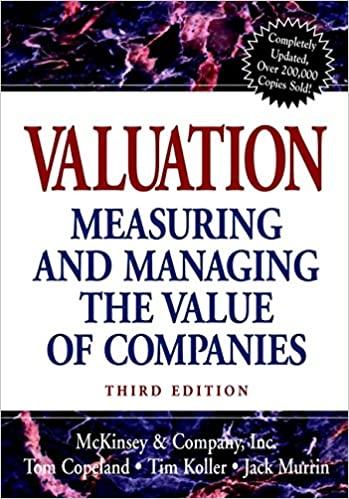Question
Please help and explain each question. Thank you! Q1. I purchase materials from a vendor in the second quarter of this year, on net 90
Please help and explain each question. Thank you!
Q1.
I purchase materials from a vendor in the second quarter of this year, on net 90 terms, putting my payment due in the third quarter.
Two weeks after my purchase, I have a finished manufactured product due. It sells in the third quarter, but I sell on credit and the payment to me is not due until the fourth quarter.
Assume both payments happen as scheduled - I pay my vendor in the third quarter, and the customer pays me in the fourth quarter. When are the cost and the revenue recorded on my financial statements, according to GAAP?
| A. | The revenue is recognized in the fourth quarter, when the money is received; the cost is recognized in the second quarter, when the cost was incurred. |
| B. | The revenue is recognized in the third quarter, when the sale was made; the cost is recognized in the second quarter, when the cost was incurred. |
| C. | The revenue and cost are both recognized in the third quarter, when the sale was made. |
| D. | The revenue is recognized in the fourth quarter, when the money is received; the cost is recognized in the third quarter, when the sale was made. |
I got C for this one.
Q2. Why would we value operations separately from cash flows generated by non-operating assets?
| a. | Trick question: there is no such thing as "non-operating assets." |
| b. | Because they are likely to bear different risks and thus need separate discount rates. |
| c. | Because it is impossible to value cash flows from non-operating assets. |
| d. | Trick question: we don't usually value them separately. |
| e. | Because the cash flows from non-operating assets cannot be estimated until we have an estimate of the value of operations. |
Q3. Name one thing a statement of cash flows is useful for in valuation.
| a. | Recording cash paid to bondholders, used to calculate historical interest payments for free cash flows and then firm value. |
| b. | Nothing. |
| c. | Obtaining historical depreciation numbers, which you then can use in your calculations of free cash flows. |
| d. | Getting historical cash obtained from operations, used as free cash flows and discounted to obtain value of operations. |
Q4. Your firm has $5 million recorded in fixed assets in the most recent year, up from $3.5 million in the previous year. What were your firm's capital expenditures over this most recent year?
| a. | $1.5 million |
| b. | $8.5 million |
| c. | $5 million |
| d. | There is not enough information to answer this question. |
Q5. When would you be most likely to use a top-down approach to forecasting revenue?
| a. | As a stable, mature firm trying to predict next year's sales for your bestselling product. |
| b. | As a startup firm estimating its first year of sales. |
| c. | As a financially distressed firm. |
| d. | As a 10-year private company about to go public in its first IPO. |
Q6.
Your firm's last three years of sales have been $1 million, $2 million, and $3 million (oldest to most recent). Year-end inventory was $250k, $500k, and $750k respectively.
You are considering purchasing an inventory system that will double your inventory turnover. Which of the following is a good estimate for the amount you'll save with regard to inventory investment next year, assuming your sales will be $4 million - i.e., what's the difference between your estimates of inventory with the system and without?
(Assume that your costs of goods sold stay at a constant percentage of sales throughout the past three years and next year; use same-year CoGS/Inv as your inventory turnover formula.)
| a. | 2000 |
| b. | 1500 |
| c. | 200 |
| d. | 500 |
Q7.
You forecast the free cash flows for your target firm over the next five years. The final cash flow, at the end of year five, is projected to be $215 million.
Assuming a FCF terminal growth rate of 2.5% and an overall discount rate of 11%, what is the present value of all future cash flows after the planning period? (Hint: do not forget to discount to today.)
| a. | $1.50 billion |
| b. | $2.59 billion |
| c. | $2.53 billion |
| d. | $1.54 billion |
| e. | There isn't enough information to answer the question. |
Q8. Which of the following formulas only includes accounts that should be used in the operating net working capital calculation?
| a. | (AR + Inventory + Short term investments) - (AP + Accrued Expenses + Short-term Debt + Current portion of LTD) |
| b. | (AR + Inventory) - (AP + Accrued Expenses + Short-term Debt + Current portion of LTD) |
| c. | (AR + Inventory) - (AP + Accrued Expenses + Short-term Debt) |
| d. | (Short term investments) - (Short-term Debt + Current portion of LTD) |
| e. | (AR + Inventory) - (AP + Accrued Expenses) |
Step by Step Solution
There are 3 Steps involved in it
Step: 1

Get Instant Access to Expert-Tailored Solutions
See step-by-step solutions with expert insights and AI powered tools for academic success
Step: 2

Step: 3

Ace Your Homework with AI
Get the answers you need in no time with our AI-driven, step-by-step assistance
Get Started


